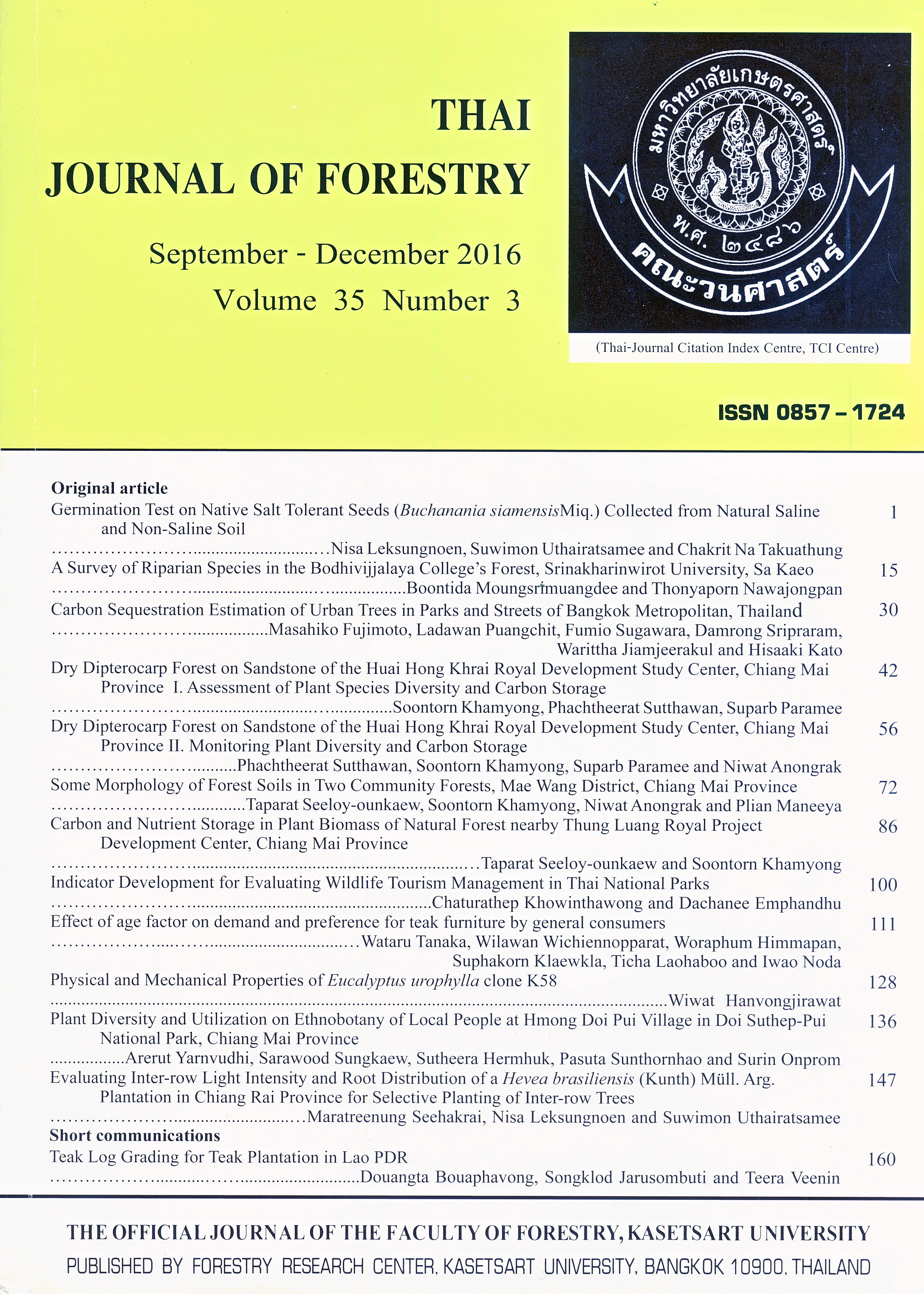Dry Dipterocarp Forest on Sandstone of the Huai Hong Khrai Royal Development Study Center, Chiang Mai Province I. Assessment of Plant Species Diversity and Carbon Storage
Main Article Content
บทคัดย่อ
Assessment of plant species diversity and carbon storage in a dry dipterocarp forest (DDF) on sandstone located in the Huai Hong Khrai Royal Development Study (HHKRDS) Center, Chiang Mai province, was carried out in 2010. Twelve plots, each of size 40 × 40 m2, were used for the vegetation study using random sampling over forest having an altitude range between 403 m and 564 m above mean sea level. The plant data were obtained by measuring the stem girth over bark at 1.3 m above ground and the height of all trees taller than 1.5 m. The quantitative characteristics of plants, plant biomass, and carbon amounts derived from the carbon contents in the stem, branch, leaf, and root were measured. The DDF was divided into four stands based on. the most dominant tree species: Hiang (Dipterocapus obtusifolius), Pluang (D. tuberculatus), Rang (Shorea siamensis), and Teng (S. obtusa), respectively, and most area was covered by the Hiang stand. There were 60 species (50 genera, 31 families) with an average density at 3,865 ± 1,669 trees ha-1 in the four stands. The average amount of plant biomass was calculated to be 83.74 ± 12.35. Mg ha-1, divided into stem, branch, leaf, and root portions with amounts of 54.45 ± 8.02 Mg ha-1, 15.71 ± 2.27 Mg ha-1, 2.08 ± 0.39 Mg ha-1, and 11.55 ± 1.85 Mg ha-1, respectively. The carbon amount in biomass was estimated to be 41.59 ± 6.26 Mg ha-1 partitioned into stem, branch, leaf, and root components of 27.16 ± 4.0 Mg ha-1 (65.30%), 7.75 ± 1.18 Mg ha-1 (18.60%), 1.02 ± 0.20 Mg ha-1 (2.50%), and 5.65 ± 0.97 (13.6%) Mg ha-1, respectively. The Hiang stand had the highest carbon storage. It was considered that this forest still has a low carbon amount stored in plant biomass because it had been a degraded forest before the establishment of the HHKDS Center in 1984.
Downloads
Article Details
ข้าพเจ้าและผู้เขียนร่วม (ถ้ามี) ขอรับรองว่า ต้นฉบับที่เสนอมานี้ยังไม่เคยได้รับการตีพิมพ์และไม่ได้อยู่ในระหว่างกระบวนการพิจารณาตีพิมพ์ลงในวารสารหรือสิ่งตีพิมพ์อื่นใด ข้าพเจ้าและผู้เขียนร่วม (ถ้ามี) ยอมรับหลักเกณฑ์และเงื่อนไขการพิจารณาต้นฉบับ ทั้งยินยอมให้กองบรรณาธิการมีสิทธิ์พิจารณาและตรวจแก้ต้นฉบับได้ตามที่เห็นสมควร พร้อมนี้ขอมอบลิขสิทธิ์ผลงานที่ได้รับการตีพิมพ์ให้แก่วารสารวนศาสตร์ คณะวนศาสตร์ มหาวิทยาลัยเกษตรศาสตร์ กรณีมีการฟ้องร้องเรื่องการละเมิดลิขสิทธิ์เกี่ยวกับภาพ กราฟ ข้อความส่วนใดส่วนหนึ่ง หรือ ข้อคิดเห็นที่ปรากฏในผลงาน ให้เป็นความรับผิดชอบของข้าพเจ้าและผู้เขียนร่วม (ถ้ามี) แต่เพียงฝ่ายเดียว และหากข้าพเจ้าและผู้เขียนร่วม (ถ้ามี) ประสงค์ถอนบทความในระหว่างกระบวนการพิจารณาของทางวารสาร ข้าพเจ้าและผู้เขียนร่วม (ถ้ามี) ยินดีรับผิดชอบค่าใช้จ่ายทั้งหมดที่เกิดขึ้นในกระบวนการพิจารณาบทความนั้น”
เอกสารอ้างอิง
Krebs, C.J. 1985. Ecology: The experimental analysis of distribution and abundance. Third edition, Harper & Row Publishers, New York, USA.
Landsberg, J.J. and S.T. Gower. 1997. Application of Physiological Ecology to Forest Management. Academic Press, Inc., USA.
Ogawa, H., K. Yoda, K. Ogino and T. Kira. 1965. Comparative ecological study on three main types of forest vegetation in Thailand. II. plant biomass. Nature and Life in Southeast Asia 4: 49-80.
Ogino, K., D. Ratanawongs, T. Tsutsumi and T. Shidei. 1967. The Primary Production of Tropical Forest in Thailand. The South-east Asian Studies 5 (1): 122-154.
Pampasit, S. 1995. Ecological study on relationship between plant association in the dry dipterocarp forest and soil properties in the Doi Inthanon National Park, Chiang Mai province. Masters Thesis, Chiang Mai University.
Phonchaluen, S. 2009. Plant species diversity, soil characteristics and utilization of Ban Sai Thong community forest, Pa Sak sub-district, Mueang district, Lamphun province. Masters Thesis, Chiang Mai University.
Phongkhamphanh, T. 2015. Plant species diversity and potentials of carbon and water storages in various community forest of Mae Tha sub-district, Mae On district, Chang Mai province. Masters Thesis, Chiang Mai University.
Seeloy-ounkeaw, T., S. Khamyong and K. Sri-ngernyuang. 2014. Variations of plant species diversity along altitude gradient in conservation and utilization community forests at Nong Tao village, Mae Wang district, Chiang Mai province. Thai J. For. 33 (2): 1-18.
Seeloy-ounkeaw, T., 2014. Plant species diversity and storage of carbon, nutrients and water in fragmented montane forest ecosystems nearby Doi Inthanon, Chiang Mai province. Ph.D. Thesis, Chiang Mai University.
Smithinand, T., T. Santisuk and C. Phengklai. 1980. The manual of Dipterocarpaceae of mainland southeast Asia. Thai For. Bull. 12: 1-110.
Tsutsumi, T., K. Yoda, P. Dhanmanonda and B. Prachaiyo. 1983. Chapter 3. Forest: Felling, burning and regeneration, pp. 13-62. In K. Kyuma and C. Pairintra, eds., Shifting Cultivation: An Experiment at Nam Phrom, Northeast Thailand and Its Implications for Upland Farming in the Monsoon Tropics. A report of a cooperative research between Thai-Japanese University, Kyoto University, Japan.
Waring, R.H. and S.W. Running. 1998. Forest Ecosystems: Analysis at multiple scales. Second edition, Academic Press, San Diego, USA.
Wattanasuksakul, S. 2012. Plant diversity, carbon sinks and nutrient accumulation in ecosystems of dry dipterocarp forest with and without fire at Inthakin Silvicultural Research Station, Chiang Mai province, Ph.D. Thesis, Chiang Mai University.
Wattanasuksakul, S., S. Khamyong, K. Sri-ngernyuang, N. Anongrak, N. 2012. Plant species diversity and carbon stocks in dry dipterocarp forest without fire at Intakin Silvicultural Research Station, Chiang Mai province. Thai J. For. 31(3): 1-14.


